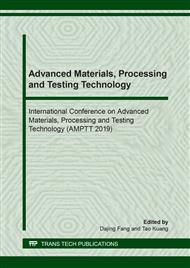[1]
Tang Pu, Long Shiguo, Li Ting, Interface defects inspection of layered structure with Chirp coded signal, Measurement & Control Technology. 36 (2017) 5 - 8.
Google Scholar
[2]
Liu H., Deng Z., Han F., et al, Time-frequency analysis of air-coupled GPR data for identification of delamination between pavement layers, Construction & Building Materials. 154 (2017) 1207 - 1215.
DOI: 10.1016/j.conbuildmat.2017.06.132
Google Scholar
[3]
Kang J M, Song S, Park D, et al, Detection of cavities around concrete sewage pipelines using impact-echo method, Tunneling & Underground Space Technology Incorporating Trenchless Technology Research. 65 (2017) 1 - 11.
DOI: 10.1016/j.tust.2017.02.002
Google Scholar
[4]
Zou D, Cui Y, A new approach for field instrumentation in grouted rock bolt monitoring using guided ultrasonic waves, Journal of Applied Geophysics. 75 (2011) 506 - 512.
DOI: 10.1016/j.jappgeo.2011.08.007
Google Scholar
[5]
Azari H, Nazarian S, Yuan D, Assessing sensitivity of impact echo and ultrasonic surface wave's methods for nondestructive evaluation of concrete structures, Construction and Building Materials. 71 (2014) 384 - 391.
DOI: 10.1016/j.conbuildmat.2014.08.056
Google Scholar
[6]
Qu Hua, Ning Jianguo, Li Xuehui, Nondestructive testing of concrete structures using the spectral analysis of Rayleigh wave, Concrete. 2 (2006) 76 - 80.
Google Scholar
[7]
Lee, Foo Wei, H. K. Chai, and K. S. Lim, Assessment of Reinforced Concrete Surface Breaking Crack Using Rayleigh Wave Measurement, Sensors. 16. 3 (2016) 337.
DOI: 10.3390/s16030337
Google Scholar
[8]
Mohseni, Hasan, and Ching-Tai Ng, Rayleigh wave propagation and scattering characteristics at debondings in fibre-reinforced polymer-retrofitted concrete structures, Structural Health Monitoring 18.1 (2019) 303 - 317.
DOI: 10.1177/1475921718754371
Google Scholar
[9]
Lee, Foo, Hwa Chai, and Kok Lim, Assessment of reinforced concrete surface breaking crack using Rayleigh wave measurement, Sensors. 16.3 (2016): 337.
DOI: 10.3390/s16030337
Google Scholar
[10]
Ghosh, Debdutta, Surendra Beniwal, and Abhijit Ganguli, Detection of defect in concrete slab using Rayleigh waves, 2015 IEEE International Ultrasonic Symposium (IUS). IEEE, (2015).
DOI: 10.1109/ultsym.2015.0338
Google Scholar


